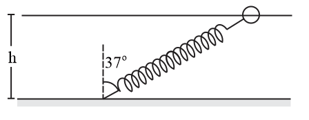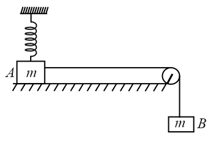Potential Energy of a Compressed or Extended Spring
Important Questions on Potential Energy of a Compressed or Extended Spring
Shows a spring fixed at the bottom end of an incline of inclination A small block of mass starts slipping down the incline from a point away from the spring. The block compresses the spring by stops momentarily and then rebounds through a distance of up the incline. Find
(a) the friction coefficient between the plane and the block
(b) the spring constant of the spring. Take

Figure shows a smooth track, a part of which is a circle of radius . A block of mass is pushed against a spring of spring constant fixed at the left end and is then released. is the initial compression of the spring so that the block presses the track with a force when it reaches the point , where the radius of the track is horizontal, then find the value of .

One end of a spring of natural length and spring constant is fixed at the ground and the other is fitted with a smooth ring of mass which is allowed to slide on a horizontal rod fixed at a height , as shown in the figure. Initially, the spring makes an angle of with the vertical when the system is released from rest. Find the speed of the ring when the spring becomes vertical.

Figure shows two blocks and , each having a mass of connected by a light string passing over a smooth light pulley. The horizontal surface on which the block can slide is smooth. The block is attached to a spring of spring constant whose other end is fixed to a support above the horizontal surface. Initially, the spring is vertical and unstretched when the system is released to move. Find the velocity of the block at the instant it breaks off the surface below it. (Take )

A small block of mass is pressed against a horizontal spring fixed at one end to compress the spring through . The spring constant is When released, the block moves horizontally till it leaves the spring. Calculate horizontal range in meter, if the ground is below the spring?

A block of mass sliding on a smooth horizontal surface with a velocity meets a long horizontal spring fixed at one end and having spring constant as shown in figure. is the maximum compression of the spring. Find the value of , here are integers.

A block of mass is attached to two unstretched springs of spring constants and as shown in figure. The block is displaced towards right through a distance and is released. The speed of the block as it passes through the mean position shown is . Fill in the blank.

Consider the situation shown in figure. Initially the spring is unstretched when the system is released from rest. Assuming no friction in the pulley, the maximum elongation of the spring is . The value of number is:

A block of mass moving at a speed compresses a spring through a distance before its speed is halved. The spring constant of the spring is . The value of is:
A block of mass is kept on a vertical spring of spring constant fixed from below. The spring is now compressed to have a length shorter than its natural length and the system is released from this position. How high does the block rise above natural length (in )? (Take )
A block of mass is suspended from the end of a vertical spring which is stretched by under the load of the block. The block is given a sharp impulse from below so that it acquires an upward speed of How high will it rise? (Take )

